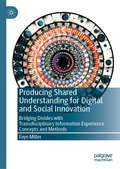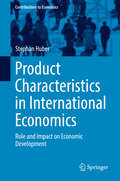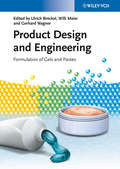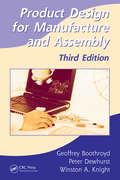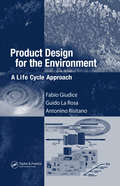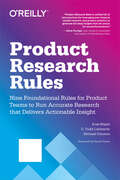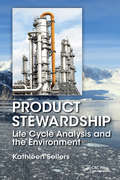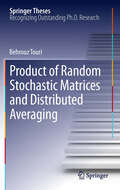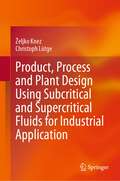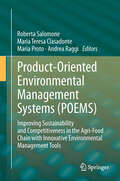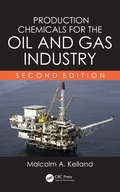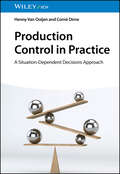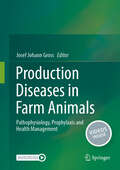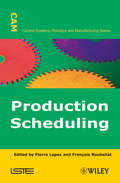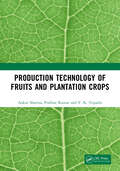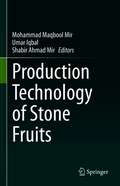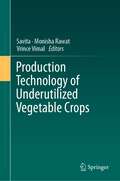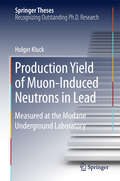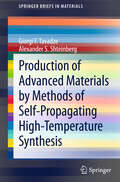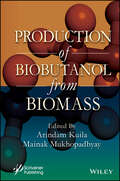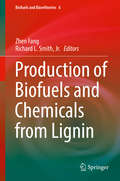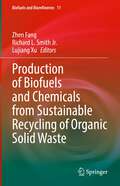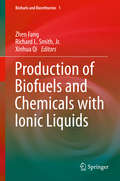- Table View
- List View
Producing Shared Understanding for Digital and Social Innovation: Bridging Divides with Transdisciplinary Information Experience Concepts and Methods
by Faye MillerIn the Anthropocene age there is a need for unifying the relationships between people, planet and technology, their interactions, experiences and impacts across ecosystems. In response to this need, this book introduces unifying bridging concepts informational waves and transdisciplinary resonance towards producing shared understanding. This book also presents emerging methods for transdisciplinary projects focusing on moments, paradoxes and dialogues for digital social innovation and sustainable development partnership goals for improving quality of life. Shared understanding is about how people from different fields and perspectives are communicating, curating, embodying, intuiting and reflecting on shared responsibilities within social ecologies. As a guide to co-designing for information experiences that create meaningful moments of shared understanding, the author illuminates essential transferable, lateral mindsets and soft skills: knowing the gaps through imagination, creativity, listening and noticing, and bridging the gaps through problem emergence, multiple stakeholders, informed learning and personal change.
Product Characteristics in International Economics: Role And Impact On Economic Development (Contributions to Economics)
by Stephan HuberNational economies are linked through flows of capital and goods. This book addresses those linkages, analyzes their benefits for economic development, and evaluates a country’s opportunities to reap the best possible rewards by influencing the linkages. The book focuses on the role of product characteristics in international economics and their impact on economic development. After an introduction to the topic, it analyzes the influence of product sophistication on growth, and offers alternative means of measuring product characteristics. In turn, the book provides evidence for the impact of foreign equity on the characteristics of the products that firms produce. Moreover, it presents empirical findings that prove that the quality of a country's legal and institutional framework is influenced by said country’s predisposition to trade rule-of-law-intensive goods.
Product Design and Engineering
by Gerhard Wagner Ulrich Bröckel Willi MeierCovering the whole value chain - from product requirements and properties via process technologies and equipment to real-world applications - this reference represents a comprehensive overview of the topic. The editors and majority of the authors are members of the European Federation of Chemical Engineering, with backgrounds from academia as well as industry. Therefore, this multifaceted area is highlighted from different angles: essential physico-chemical background, latest measurement and prediction techniques, and numerous applications from cosmetic up to food industry.Recommended reading for process, pharma and chemical engineers, chemists in industry, and those working in the pharmaceutical, food, cosmetics, dyes and pigments industries.
Product Design for Manufacture and Assembly
by Geoffrey Boothroyd Peter Dewhurst Winston A. KnightHailed as a groundbreaking and important textbook upon its initial publication, the latest iteration of Product Design for Manufacture and Assembly does not rest on those laurels. In addition to the expected updating of data in all chapters, this third edition has been revised to provide a top-notch textbook for university-level courses in product
Product Design for the Environment: A Life Cycle Approach
by Antonino Risitano Fabio Giudice Guido La RosaIn recent years the increased awareness of environmental issues has led to the development of new approaches to product design, known as Design for Environment and Life Cycle Design. Although still considered emerging and in some cases radical, their principles will become, by necessity, the wave of the future in design. A thorough exploration of t
Product Development within Artificial Intelligence, Ethics and Legal Risk: Exemplary for Safe Autonomous Vehicles
by Thomas WinkleThis open-access-book synthesizes a supportive developer checklist considering sustainable Team and agile Project Management in the challenge of Artificial Intelligence and limits of image recognition. The study bases on technical, ethical, and legal requirements with examples concerning autonomous vehicles. As the first of its kind, it analyzes all reported car accidents state wide (1.28 million) over a 10-year period. Integrating of highly sensitive international court rulings and growing consumer expectations make this book a helpful guide for product and team development from initial concept until market launch.
Product Research Rules: Nine Foundational Rules For Product Teams To Run Accurate Research That Delivers Actionable Insight
by C. Todd Lombardo Michael Connors Aras BilgenDigital product research doesn't have to be difficult, take a long time, or cost a lot of money. Nor should it be a job solely for scientists or expert researchers. In this practical book, Aras Bilgen, C. Todd Lombardo, and Michael Connors demonstrate how your entire team can conduct effective product research within a couple of weeks--easily, cheaply, and without compromising quality.Drawing from decades of experience in product development, the authors lay out nine simple rules that combine user research, market research, and product analytics to quickly discover insights and build products customers truly need.Recognize and avoid common research pitfallsSwitch to the insight-making mindset that underlies all successful research effortsFind out how to look at data, formulate the right questions, and pick the right research methodLearn interview techniques and research skillsAnalyze for insights collaboratively while avoiding biasInspire action with your insights through powerful presentations and prototypesLearn how to involve a wide variety of stakeholders in research, from developers to executivesDiscover how you can make research a habit, not a one-off effort
Product Stewardship: Life Cycle Analysis and the Environment
by Kathleen SellersConsider the Consequences of Bringing a Chemical to MarketProduct Stewardship: Life Cycle Analysis and the Environment explores the regulatory and scientific aspects of the life-cycle consequences of bringing a chemical to market. Using case studies to bring critical points to life, this multidisciplinary text explores the factors that influence ou
Product of Random Stochastic Matrices and Distributed Averaging
by Behrouz TouriThe thesis deals with averaging dynamics in a multiagent networked system, which is a main mechanism for diffusing the information over such networks. It arises in a wide range of applications in engineered physical networks (such as mobile communication and sensor networks), as well as social and economic networks. The thesis provides in depth study of stability and other phenomena characterizing the limiting behavior of both deterministic and random averaging dynamics. By developing new concepts, and using the tools from dynamic system theory and non-negative matrix theory, several novel fundamental results are rigorously developed. These contribute significantly to our understanding of averaging dynamics as well as to non-negative random matrix theory. The exposition, although highly rigorous and technical, is elegant and insightful, and accompanied with numerous illustrative examples, which makes this thesis work easily accessible to those just entering this field and will also be much appreciated by experts in the field.
Product, Process and Plant Design Using Subcritical and Supercritical Fluids for Industrial Application
by Christoph Lütge Željko KnezThis book describes cutting edge technology using supercritical fluids for the production of foodstuffs, medicals, and polymers. It illustrates the importance and use of basic data for design and operation at industrial scale units. The book's authors have several decades of experience of applied research on how to develop large scale industrial units. It provides readers complete insight in design and operation of industrial high pressure process plants. The book is written so it may be understood for people (with?) little or no background on high pressure process technology. It will provide information on how some foodstuffs, medicals, polymers are produced using high pressure technologies. The book demonstrates the importance of fundamental data, how to measure them and how to apply them to design industrial plants. At the same time, it also serves as a textbook for students.
Product-Oriented Environmental Management Systems (POEMS): Improving Sustainability and Competitiveness in the Agri-Food Chain with Innovative Environmental Management Tools
by Roberta Salomone Maria Teresa Clasadonte Maria Proto Andrea RaggiRepresenting the coordinated work of a research group from four different Italian University departments which conducted the Eco-Management for Food (EMAF) Project, this book offers a systematic approach for managing and improving the environmental aspects of agri-food processes and products using Product-Oriented Environmental Management Systems (POEMS).
Production Chemicals for the Oil and Gas Industry
by Malcolm A. KellandThis text discusses a wide variety of production chemicals used by the oil and gas industry for down-hole and topside applications both onshore and offshore. It reviews all past and present classes of production chemicals, providing numerous difficult-to-obtain references. Unlike other texts that focus on how products perform in the field, this book focuses on the specific structures of chemicals that are known to deliver the required or desired performance. Where known, it also details the environmental aspects of the chemicals discussed and their success in the field.
Production Control in Practice: A Situation-Dependent Decisions Approach
by Henny Van Ooijen Corné DirneProduction Control in Practice Practice-oriented coverage of production planning and control processes for goods and services, written for any industry Production Control in Practice explores the operational control of production and inventory processes in organizations across industries, covering both tangible and intangible products and offering viable, efficient solutions to characteristic production control problems, such as what goods to produce when and how. A number of examples/stylized applications are included to help readers understand and apply the discussed concepts and theories to their own organizations. This book distinguishes between the control of production units and the control of goods flow between these units and the market and discusses various coordination and material supply control mechanisms relevant to supply chains. It also presents a typology of production situations found in practice, using a structured approach to discussing the relevant control decisions for each situation. This book is unique because (basic) control decisions are discussed for the different characteristic Decoupling Point Control and Production Unit Control situations from a holistic point of view, taking into account both mathematical considerations as well as various situational factors. Sample topics covered in Production Control in Practice include: Terminology and concepts used in production control, including complexity, uncertainty, and flexibilityTypes of release triggers, covering just-in-time versus just-in-case and push versus pull in logisticsHorizontal and vertical decomposition, and time series-related forecasting for stationary demand versus demand with trendOrder size, covering optimal batch size in case of fixed order size, relaxation of assumptions, and single period considerationsMRP systems, covering Material Requirements Planning (MRP-I) and Manufacturing Resource Planning Systems (MRP-II) With excellent coverage of the subject across different products and industries and several examples to help readers follow along, Production Control in Practice is an ideal reference for bachelor students from universities of applied sciences and academic bachelor students, as well as practitioners in related disciplines.
Production Diseases in Farm Animals: Pathophysiology, Prophylaxis and Health Management
by Josef Johann GrossThis textbook deals comprehensively with livestock production diseases and their prevention in the major species: ruminants, swine, and poultry. It gives an interdisciplinary view on pathophysiology, prophylaxis, and health management.Livestock breeding and husbandry is often accompanied by a conflict of interest between the animal´s biological requirements and economic producer needs. This conflict is increasingly gaining attention not only by producers, animal scientists, and veterinarians, but also by the public. It creates significant future challenges, which are described and addressed in this book. The main topics covered are: • the use of antimicrobials with emphasis on security and safety for producers/consumers• the impact of locomotion disorders on performance and welfare of farm animals • the interactions of gut microbiome, genetics, climate change, metabolic status and mineral homeostasis with reproduction, performance, animal health and welfare• infectious and respiratory diseases• the raising of neonatesA special section is devoted to behavioural signs indicating an impaired animal welfare. These are the basis for precision livestock farming (PLF) technology and the development of new management concepts. The present work is a valuable resource for veterinarians, students, as well as expert readers from animal and agricultural sciences, food safety and technology. Supplementary videos can be accessed online as well as directly from the print book; simply download the Springer Nature More Media App for free and scan the links with the play button.
Production Scheduling (Wiley-iste Ser.)
by François Roubellat Pierre LopezThe performance of an company depends both on its technological expertise and its managerial and organizational effectiveness. Production management is an important part of the process for manufacturing firms. The organization of production relies in general on the implementation of a certain number of basic functions, among which the scheduling function plays an essential role. This title presents recently developed methods for resolving scheduling issues. The basic concepts and the methods of production scheduling are introduced and advanced techniques are discussed, providing readers with a comprehensive and accessible guide to employing this process.
Production Technology of Fruits and Plantation Crops
by Prabhat Kumar Ankur Sharma V. K. TripathiBased on the 5th Dean’s committee of ICAR and NEP 2020, this book provides an overview of the important aspects of fruit crops. It covers all important fruit crops including tropical, subtropical, temperate, and arid fruits. The subject matter in this book also discusses the importance and scope of fruit and plantation crop industry in India and the importance of rootstocks.Print edition not for sale in South Asia (India, Sri Lanka, Nepal, Bangladesh, Pakistan or Bhutan)
Production Technology of Stone Fruits
by Shabir Ahmad Mir Mohammad Maqbool Mir Umar IqbalGlobally stone fruits are emerging in the market due to the increased consumer’s desire for health-promoting foods. Stone fruits attract research attention, mainly due to the cultural and commercial aspects of the array of varieties that are grown. Being grown in wide range of environments, it is very important to understand what factors influence the production and quality attributes of stone fruits. There is a lack of systematic scientific information on strategic approach for production technologies of such fruits. This book will be first of its kind focusing on technological aspects of stone fruits especially on latest developments in present day horticulture. It will be an essential reference for professionals including academicians, scholars, researchers and industries working in the said area. We hope that readers will find this book a useful resource for their research or studies, and it will be helpful in the development of high quality stone fruits in future which will improve the economic and social life of people. Besides, this book fulfills the needs of a number of horticultural courses of Universities and will serving as a pomological manual for all occasions.
Production Technology of Underutilized Vegetable Crops
by Savita Monisha Rawat Vrince VimalThis volume discusses the nutraceutical importance, production technologies, management and cultivation practices of underutilized vegetables, which can be described as those vegetable crops which are neither grown commercially on a large scale nor traded widely. While much of the crops addressed in the book are cultivated, traded and consumed at the local level, there are over 60 species of minor vegetables with high growth and yield potentials that are not cultivated to a large extent for greater populations. This work highlights the production technologies needed to grow these vegetables on a larger scale and under various adverse soil and climatic conditions, and their nutritional and medical benefits to assist with food security, health and poverty alleviation in rural areas. Production of underutilized vegetables is low, due to the unavailability of planting material, lack of awareness about the nutritional and medicinal importance among the farmers and inadequate information on the production techniques of these crops. In this context, there is an urgent need to take up a program on genetic resources exploration, management, utilization, and improvement of underutilized vegetable crops to ensure food and nutritional security. Readers will learn about these technologies and practices, while also learning about the unique properties and benefits of these underutilized vegetables. The book will be useful for academicians and researchers focusing on vegetable production and breeding, as well as farmers and sustainability scientists looking for underexplored sources of nutrition to benefit large rural populations.
Production Yield of Muon-Induced Neutrons in Lead
by Holger KluckThe work presented in this book is a major step towards understanding and eventually suppressing background in the direct search for dark matter particles scattering off germanium detectors. Although the flux of cosmic muons is reduced by many orders of magnitude in underground laboratories, the remaining energetic muons induce neutrons through various processes, neutrons that can potentially mimic a dark matter signal. This thesis describes the measurement of muon-induced neutrons over more than 3 years in the Modane underground laboratory. The data are complemented by a thorough modeling of the neutron signal using the GEANT4 simulation package, demonstrating the appropriateness of this tool to model these rare processes. As a result, a precise neutron production yield can be presented. Thus, future underground experiments will be able to reliably model the expected rate of muon-induced neutrons, making it possible to develop the necessary shielding concept to suppress this background component.
Production and Commercialization of Insects as Food and Feed: Identification of the Main Constraints in the European Union
by Francesco Montanari Ana Pinto de Moura Luís Miguel CunhaForecasts point out an exponential growth in the global population, which raises concerns over the ability of the current agri-food production systems to meet food demand in the long term. Such a prospect has led international organizations and the scientific community to raise awareness about, and call for, the need to identify additional sources of food to feed the world. From this perspective, insects qualify as a suitable and more environmentally friendly alternative to meat and other foods that are sourced from animal proteins. However, uptake of the production and commercialization of insects as food has been facing regulatory hurdles, consumer skepticism and rejection in many markets. This is particularly true in the context of western societies in which insects do not always constitute part of the local traditional diets.Production and Commercialization of Insects as Food and Feed: identification of the Main Constraints in the European Union analyses and discusses the regulatory state-of-the-art for the production and commercialization of insects as food and feed in the European Union. The EU has been taking concrete legislative steps with a view to opening up its market for insect foods, although some key regulatory constraints still exist today which ultimately prevent the industry sector from growing, consolidating and thriving. The main regulatory constraints in the EU for insects as food include the fragmentation of the EU market as a result of the adoption of different policy solutions by EU Member States for novel foods and the lengthy and complex authorization procedures. Also, ad hoc safety and quality requirements tailored to the needs and specificities of the insect food sector are currently missing.This work constitutes the first comprehensive overview of the evolution and current state-of-the-art of the regulatory framework for insect foods in the EU, based on a multidisciplinary approach that combines science, policy and law. It proposes a legislative roadmap which the EU should follow in order to make its regulatory framework fit for insect foods in the long term by providing a detailed comparison between the current EU legal framework and other regulatory systems of western countries with a view to singling out the markets which are better equipped to address the production and the commercialization of insect foods. The text provides an updated overview of the overall market and of European consumers’ perspectives on the use of insect foods. With the proper legislative steps and consolidation, the EU can be a global leader for insects as food and feed both as a market and as a standard-setting body.
Production of Advanced Materials by Methods of Self-Propagating High-Temperature Synthesis
by Alexander Shteinberg Giorgi F TavadzeThis translation from the original Russian book outlines the production of a variety of materials by methods of self-propagating high-temperature synthesis (SHS). The types of materials discussed include: hard, refractory, corrosion and wear-resistant materials, as well as other advanced and specialty materials. The authors address the issue of optimal parameters for SHS reactions occurring during processes involving a preliminary metallothermic reduction stage, and they calculate these using thermodynamic approaches. In order to confirm the effectiveness of this approach, the authors describe experiments focusing on the synthesis of elemental crystalline boron, boron carbides and nitrides. Other parts of this brief include theoretical and experimental results on single-stage production of hard alloys on the basis of titanium and zirconium borides, as well as macro kinetics of degassing and compaction of SHS-products. This brief is suitable for academics, as well as those working in industrial manufacturing companies producing hard alloys and composites for making metal-working machinery or drilling equipment.
Production of Biobutanol from Biomass
by Arindam Kuila Mainak MukhopadhyayPRODUCTION of BIOBUTANOL from BIOMASS The book covers all current technologies of lignocellulosic biobutanol production as well as the environmental and socioeconomic impact assessment. N-butanol is a bulk chemical that is used as an industrial solvent and as a component in paint, coatings, and adhesives, among other things. When compared to other biofuels, biobutanol has the advantages of being immiscible in water, having a higher energy content, and having a lower vapor pressure. There are various benefits to producing biobutanol from lignocellulosic biomass. However, there are challenges in producing butanol from lignocellulosic biomass, such as biomass’s complex structure, low butanol yield, and high cost of production, etc. The 13 chapters comprising this book discuss the current technology and prospects of biobutanol production. The first four chapters provide an overview of the current technological status, while the next six chapters discuss different strategies for enhanced biobutanol production from lignocellulosic biomass. The last three chapters present the industrial status and techno-economic analysis of lignocellulosic biobutanol production. Audience The book will be useful for researchers in the areas of various branches of life sciences such as environmental biotechnology, bioprocess engineering, renewable energy, chemical engineering, nanotechnology, biotechnology, microbiology.
Production of Biofuels and Chemicals from Lignin
by Richard L. Smith Jr. Zhen FangThis book provides state-of-the-art reviews, current research on and the prospects of lignin production, biological, thermal and chemical conversion methods, and lignin technoeconomics. Fundamental topics related to lignin chemistry, properties, analysis, characterization, and depolymerization mechanisms, as well as enzymatic, fungal and bacterial degradation methods are covered. The book also examines practical topics related to technologies for lignin and ultra-pure lignin recovery, activated carbon, carbon fiber production and materials, and addresses the biological conversion of lignin with fungi, bacteria or enzymes to produce chemicals, along with chemical, catalytic, thermochemical and solvolysis conversion methods. Lastly, it presents a case study on practical polyurethane foam production using lignin. Lignin has a bright future and will be an essential feedstock for producing renewable chemicals, biofuels and value-added products. Offering comprehensive information on this promising material, the book represents a valuable resource for students, researchers, academicians and industrialists in the field of biochemistry and energy.
Production of Biofuels and Chemicals from Sustainable Recycling of Organic Solid Waste (Biofuels and Biorefineries #11)
by Richard L. Smith Zhen Fang Lujiang XuThis book covers sustainable recycling processes (e.g. physical, biological, chemical, and thermo-chemical) of multiple organic solid wastes, provides methods for material recycle of wastes into value-added products including fuels and commodity chemicals that are able to be directly applied to promote manufacturing processes. Aimed at improving the awareness of effective conversion protocols and for developing innovative biomass conversion processes, this text was conceived as a collection of studies on state-of-art techniques and know-how for production of biofuels and chemicals from sustainable recycling of organic solid wastes. Topics in the text are discussed in terms of addressing recent advances, assessing and highlighting promising new methods or new technological strategies and direct conversion of organic solid wastes to process feeds. Highly-recognized authorities, experts and professionals have contributed individual chapters in selected areas to cover the overall topic in a comprehensive manner.
Production of Biofuels and Chemicals with Ionic Liquids
by Richard L. Smith Zhen Fang Xinhua QiThe application of ionic liquids to biomass for producing biofuels and chemicals will be one of the hot research areas during the next decade due to the fascinating properties of these versatile group of solvents that allow them to dissolve lignocellulosic materials. The present text provides up-to-date fundamentals, state-of-the-art reviews, current assessments and prospects in this area, including aspects of pretreatment, fermentation, biomass dissolution, cellulose transformation, reaction kinetics and physical properties, as well as the subsequent production of biofuels and platform chemicals such as sugars, aldehydes and acids. Auxiliary methods such as catalysis, microwave and enzymatic techniques used in the transformations are covered. Both researchers and practitioners are certain to find a wealth of information in the individual chapters, which were written by experts in the field to provide an essential basis for assessing possible pretreatment and transformation routes of biomass using ionic liquids, and for developing new methods and chemical processes. Dr. Zhen Fang is Professor of Bioenergy, head of the Chinese Academy of Sciences' Biomass Group, Xishuangbanna Tropical Botanical Garden and is also an Adjunct Professor of Life Sciences, University of Science and Technology of China. Dr. Richard L Smith, Jr. is Professor of Chemical Engineering at the Graduate School of Environmental Studies, Research Center of Supercritical Fluid Technology, Tohoku University, Japan. Dr. Xinhua Qi is Professor of Environmental Science at Nankai University, China.
